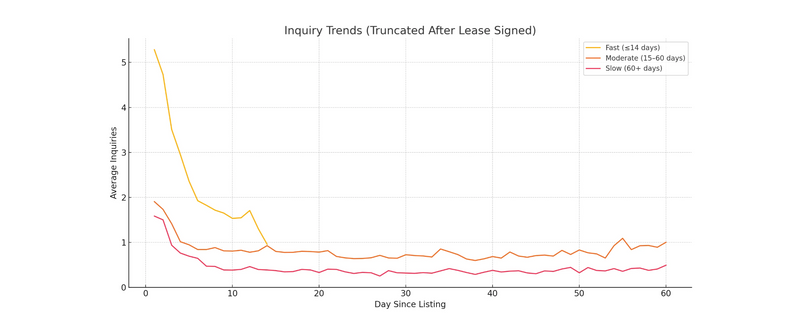Updated 5 months ago on .
How do you know if your marketing is going well? How many renter inquiries?

Intro:
Leasing your home for the first time can feel overwhelming. You’ve done the hard work—gotten your home rent-ready, taken great photos, and listed it online. Now what? How do you know if your listing is performing well, what early signs to watch for, and what to do if your home isn’t getting the attention you hoped for?
We analyzed thousands of rental listings to help first-time landlords understand what to expect—and what to do if expectations don’t match reality.
1. What a “Healthy” Listing Looks LikeIn most cases, strong-performing listings follow a clear pattern: high inquiry volume in the first 7 days. These inquiries—messages or calls from interested renters—are a leading indicator that your property is priced competitively and attracting attention.
In fact, our data shows:
- Homes that lease within 7 days receive over 20 inquiries in the first week
- Homes that take 30+ days to lease often see less than half that in the same time frame
💡 If you're not seeing early interest, that's a signal to act—quickly.
2. Set Realistic Expectations—and Track the Right MetricsWhile some homes lease fast, many take longer. The keys to managing your expectations:
- Watch the first 7–14 days closely. That window is when most leases are signed—or momentum is built.
- Track inquiries daily. If you’re using a platform, you’ll see these automatically. If not, keep a simple log.
- Don’t just wait it out. Time on market without activity is a risk. Renters shop quickly—and your listing can go stale.
If you’re past day 7 and your inbox is quiet, here’s what we recommend:
✅ Review your pricing:
Most slow-leasing homes are priced too high. A price drop—even a small one—can restart momentum. Homes with price reductions often see a spike in inquiries within 48 hours.
✅ Refresh your listing:
Update your headline or photos. Small tweaks help your home stand out to renters browsing daily.
✅ Reassess timing:
Is it off-season in your market? Are you targeting a move-in date that’s too far out? Adjust to meet renter demand.
It’s easy to feel discouraged if leasing takes longer than expected. But leasing is a process. With the right adjustments, nearly every home will find the right tenant.



